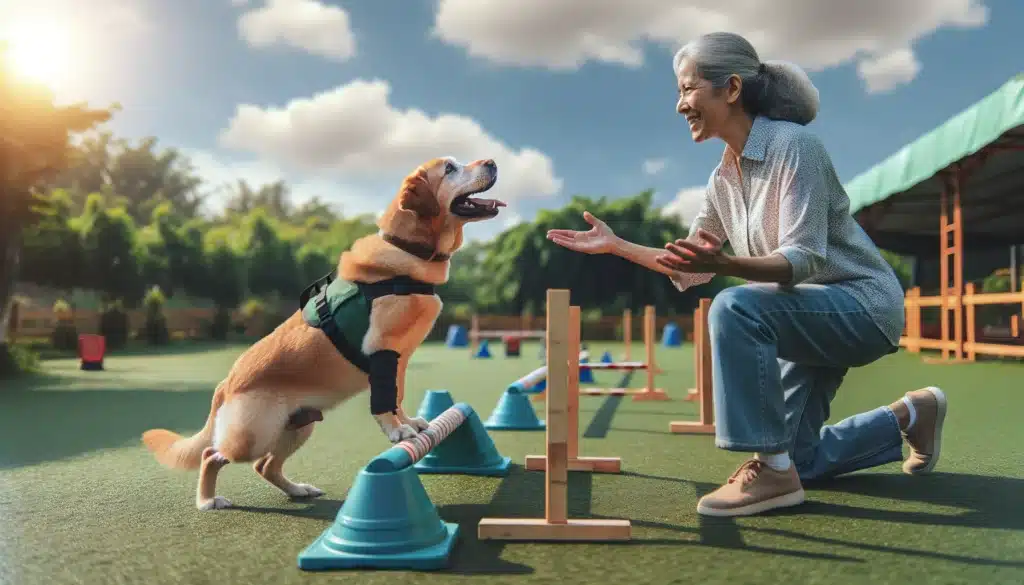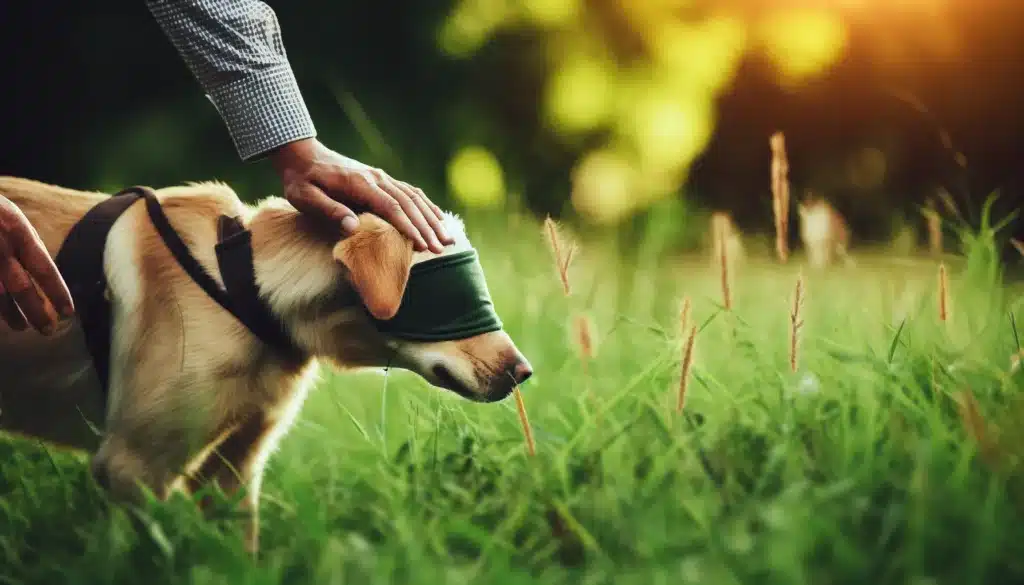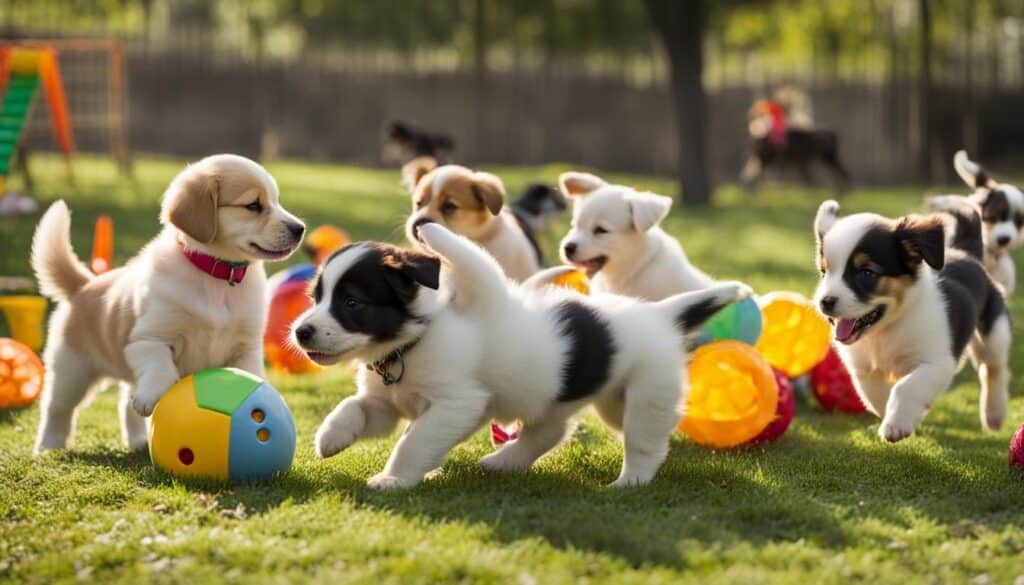Dogs with special needs need custom training. This helps them with their unique challenges. We’ll look at training for physical disabilities, brain conditions, and behavior problems. Knowing and meeting your dog’s unique needs makes a big difference. It helps them succeed and face their challenges.

Key Takeaways:
- Training dogs with special needs require customized approaches to address their unique disabilities and challenges.
- Physical disabilities, neurological conditions, and behavioral challenges are crucial when training special needs dogs.
- Understanding your dog’s needs, consulting a veterinarian, and observing their behavior are essential to designing effective training programs.
- Positive reinforcement training techniques and utilizing a dog’s most vital senses can aid in training dogs with special needs.
- Training approaches differ for specific disabilities such as blindness, deafness, limited mobility, anxiety, and behavioral issues.
Training dogs with special needs means understanding the obstacles they face. Dogs might have physical disabilities, neurological conditions, or behavioral issues. This part aims to cover special needs in dogs. It helps dog owners know what their pets might require.
What are “Special Needs” in Dogs?
“Special needs” for dogs cover many areas. These include physical, neurological, and behavioral challenges they might face. For example, dogs might be blind, have seizures, or struggle with anxiety. Each issue needs a different training approach to help the dog live its best life.
Physical Disabilities (Blindness, Deafness, Amputations)
Physical disabilities change how dogs interact with the world. Blind dogs use their other senses and need signs without words. Deaf dogs look for visual clues and touch. Dogs with missing limbs might need help with specific training to compensate. It’s critical to know and adjust for these needs.
Neurological Conditions (Seizures, Anxiety)
Dogs facing seizures or anxiety have specific training needs. Seizures mean training should be calm and stress-free. Anxious dogs may need a little extra patience and encouragement. It’s critical to tailor training to their unique requirements for their health and happiness.
Behavioral Challenges
Dogs with behavior problems need targeted training. This includes positive reinforcement, retraining bad habits, and possibly expert help. Figuring out the root of the problem is half the battle. This way, you can design training that meets the dog’s needs.
Understanding Your Dog’s Needs
To train a dog with special needs well, you must deeply know what they require. Understanding your dog’s needs lets you customize your training. This ensures they do well and are happy.

Consulting a Veterinarian
Talking to a vet when training a dog with special needs is critical. Vets offer tips on training that fit your dog’s specific situation. They can also check for any health issues or pain that affect learning.
Observing Your Dog’s Behavior
Watching your dog closely helps spot challenges and strengths. Look at how they react to different things and interact with others. This enables you to learn what scares them, what they’re good at, and how they learn best.
Identifying Strengths and Weaknesses
Knowing what your dog is good and not so good helps shape their training. Knowing their strengths helps boost their confidence. This makes them eager to learn. And working on their weaknesses helps train them better.
| Strengths | Weaknesses |
| Quick learning ability | Fear of loud noises |
| Excellent recall | Separation anxiety |
| Good with other dogs | Leash aggression |
Taking advantage of their strengths and working on their weaknesses can improve training. It makes a program that helps your dog do their best and stay happy.
Considering Your Dog’s Learning Style
Training a dog with special needs is critical to thinking about their unique learning way. Like us, dogs have different ways of learning and react to how they are trained. Knowing and adjusting to their style makes training work well and be positive.
Positive Reinforcement vs. Punishment-Based Training
Many see positive reinforcement as the best way to train all dogs. It means you reward the good things they do with treats or play. This helps your dog know they’re doing the right thing. Punishing a dog for bad behavior can scare them and harm their trust in their owner.
Using rewards can make training fun. This is great for dogs with special needs because it helps them feel good and trust you more.
Utilizing a Dog’s Strongest Senses (Sight, Smell, Hearing)
Dogs learn about the world primarily through their senses. Focusing on what they see, smell, and hear is essential when working with a special needs dog. This includes using things they can see, smell, and hear to help them learn better.
For dogs that can’t see well, you can use your hands to show them what to do. And for all dogs, hiding things for them to find by smell is a fun way to learn. Doing this boosts their thinking skills and confidence. Clickers or other sounds can also be used, helping dogs who can’t hear or see.
Clicker Training for Deaf or Blind Dogs
Clicker training works well for dogs that can’t hear or see much. A clicker makes a clear sound when they do something good. They then get a reward, which helps them understand they did well.
If a dog can’t hear the click, you can teach them by touching or smelling certain smells. And if they can’t see well, the click, feel, or smell can all be put together to show the dog what you want them to do.
Scent Work Activities for All Dogs
Scent work is suitable for all dogs. You can make your dog happy and think more by doing scent activities. This is true for all dogs, no matter what.
You can start by hiding a toy or treats for the dog to find. This uses their nose to see things and makes them think. It’s a fun way for them to learn.
Even dogs with special needs can do this. For example, dogs that can’t see can learn to find things by smell. And those who can’t hear well can do the same. These activities help them in different ways.
You can make training fun and effective by thinking about how your dog learns best and using good, positive ways to train them. This is especially true for dogs with special needs.
Training a Blind Dog
Training a blind dog uses unique methods to help them out. It’s essential to understand their needs. By using the proper techniques, you can keep them safe and make their life better.
Importance of Routine and Consistency in Environment
Blind dogs need a routine and a steady environment. They use things they know to move around safely. Keeping things the same helps them understand and feel safe.
Using Verbal Cues and Tactile Signals
Communication is vital with blind dogs. Use precise words and the same tone every time you talk. Also, gentle touches can make your messages more straightforward. Being consistent with both words and touches is essential.
“Touch Target” Training for Navigation
“Touch target” training can help a blind dog get around. Start with a target in one spot and reward them for touching it. Move the target around to teach them to find their way.
Scent Work for Object Location

For finding objects, scent work is excellent. For example, let them learn a scent and link it to a toy. With practice, they will use their nose to find things well.
| Training Technique | Description |
| Routine and Consistency | Establish and maintain a consistent environment and routine to help blind dogs navigate safely. |
| Verbal Cues and Tactile Signals | Use clear and consistent verbal cues and incorporate gentle tactile signals to communicate effectively. |
| “Touch Target” Training | Teach blind dogs to navigate based on touch targets or objects placed in specific locations. |
| Scent Work | Introduce scent cues and associate them with specific objects to help blind dogs locate desired items. |
Training a Deaf Dog
This part looks into how to train a deaf dog. Because they can’t hear, they face challenges in understanding us. But there are ways to help them. We can use visual cues, vibration collars, and unique training methods. These can make training much better for deaf dogs.
Utilizing Visual Cues (Hand Signals, Body Language)
Deaf dogs need to see what we’re telling them. So, using hand signals and body language is critical. Make sure your signals are clear and easy to see. This way, everything is clear.
Showing your hands at your chest level helps the dog see them better. For instance, an open hand facing them means “stay.” A pointed finger can mean “go” or “come”.
Vibration Collars (Use with Caution and Positive Reinforcement)
Vibration collars are also suitable for deaf dogs. They vibrate to get the dog’s attention. But remember, they should always be used with care. It’s essential to make sure the dog likes the vibration. It should never be scary for them.
Focusing on Touch and Play-Based Training
Touch and play are great ways to help deaf dogs learn. Dogs understand a lot through touch. For example, gently push their bottom down for “sit.”
Playing games is fun for dogs. It also helps in training. Use toys and encourage good behavior with treats or praise. This makes learning a positive experience.
Being consistent and patient is very important in training deaf dogs. Always reward reasonable efforts. Keep in mind that each dog is different. So, adjust your training to what works best for them.
Training a Dog with Limited Mobility
Training dogs with limited mobility takes special care and methods. These dogs need help moving around or doing some tasks. But they can still grow and learn with the right help. Here are tips to teach them:
Short, Positive Training Sessions
It’s critical to have short and fun training times for these dogs. They get tired quickly, so small sessions are best. This keeps them interested and stops them from getting too tired.
Focus on Mental Stimulation and Calm Commands
Along with physical exercises, it’s essential to keep their minds busy. Use toys, scent activities, and games to keep them sharp. Also, always use calm words and be gentle to keep them focused.
Utilizing Treats Delivered Close to the Dog
For these dogs, make sure treats are easy for them to get. Place treats by their mouth or on a low stand. This will encourage them during training.
Considering Adaptive Equipment (Ramps, Harnesses)
Special gear like ramps and harnesses can help a lot. Ramps let them go over barriers or reach high places. Harnesses give them extra support. These tools can improve their training and daily life.
| Training Strategies for Dogs with Limited Mobility | Benefits |
| Short, positive training sessions | Prevents fatigue and maintains focus |
| Focus on mental stimulation and calm commands | Provides mental exercise and reduces anxiety |
| Utilizing treats delivered close to the dog | Ensures easy access to rewards |
| Considering adaptive equipment (ramps, harnesses) | Aids in mobility and provides support |
Training a Dog with Anxiety or Behavioral Issues
Dogs facing anxiety or behavioral issues need your patience and understanding. It’s crucial to spot what sets them off and address these issues. You can help them by slowly getting them used to their triggers. This can change how they react. Giving them good experiences also boosts their self-esteem. Sometimes, working with a pro dog trainer is wise. They can make a plan just for your dog.
Identifying Triggers and Addressing Underlying Causes
To help a dog with anxiety or behavioral issues, find out what makes them upset. These triggers could be loud noises or new places. By watching your dog and noting what’s scary, you can figure out the real reasons for their troubles.
Desensitization and Counterconditioning Techniques
Desensitization means slowly exposing your dog to what they fear or react to safely. They can learn not to fear these things by starting small and going slow. Counterconditioning is also crucial. It’s about turning bad things into good by adding something they love.
Building Confidence Through Positive Experiences
Boosting your dog’s confidence can help a lot with their anxiety and behavior. Fun activities like playtime, training, or using toys can make a big difference. Be sure to cheer them on and reward good actions. This positive reinforcement helps a lot.
Consulting a Professional Dog Trainer (Optional)
If you need help with your dog, a professional dog trainer can be a great choice. They’re experts in dealing with anxious or troubled dogs. They’ll create a plan specifically for your furry friend and support you. They’re also great at handling any deep-seated behavior issues.
Resources and Additional Support
It’s critical to understand the unique needs of dogs with special needs. Getting the right resources and support is vital for their training and well-being. This section shares info on resources to help dog owners train their special needs pets.
Online Resources and Training Guides for Dogs with Special Needs
Many online resources and guides are made for dogs with special needs. They provide helpful tips and techniques for training dogs with disabilities, brain conditions, and behavior issues. Owners learn step by step to help their special needs dogs.
Organizations Providing Service Dog Training
Service dog training groups are essential for people with special needs. They have programs that train dogs to help with specific disabilities. These organizations offer professional help and support to ensure service dogs are ready for their tasks.
Professional Dog Trainers Specializing in Special Needs Cases
Professional dog trainers can be a big help. They focus on dogs with disabilities and other special needs. These trainers create personalized plans for each dog, helping them succeed.
Conclusion
Training dogs with special needs needs a unique plan to help them overcome obstacles. Understanding these issues lets dog owners create the best environment for their pets to grow and thrive.
Owners must work closely with a vet to spot their pet’s needs and watch how they act. Knowing what your dog is good at and where they struggle helps tailor their training. It’s also crucial to pick a training style that matches your dog, like using treats for good behavior or focusing on what they can smell.
Visually impaired dogs do well with a set routine and commands they can hear or feel. For deaf dogs, it’s about using clear hand signals and understanding their body language with the help of vibration collars. When a dog can’t move well, short, fun training times and games to keep their mind busy are great.
If a dog is anxious or acts out, it’s about finding what upsets them and slowly getting them used to it. You can also help these dogs by creating positive moments that boost their confidence.
There are many ways to get help in training dogs with special needs. You can find help online, in training books, or from groups that work with service dogs. There are also experts in dog training for exceptional cases. Using these resources, owners can give their special dogs a joy-filled life.

